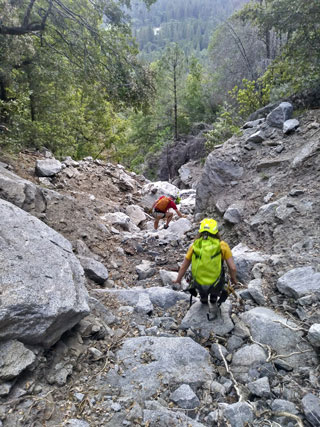Late in the morning of Friday, June 8, 2018, the Yosemite Emergency Communications Center received a call from an off-trail hiker who reported he was in a position where he didn’t feel he could safely ascend or descend (“ledged out”) in Indian Canyon. The subject had intended to travel from Yosemite Valley to the North Rim via Indian Canyon after reading a few trip reports online. He was experienced in off-trail travel, but afterwards stated that he was not familiar with terrain where, “knowing where you are and where you need to go is not enough.” After becoming ledged out, the subject realized that he had gone the wrong way and was not in Indian Canyon; he had ascended an adjacent canyon. He then attempted to descend from the ledge, but realized he did not recognize the terrain around him. At that point, he sat down, ate lunch, and evaluated his options and the terrain around him.

The subject provided his GPS coordinates and two search and rescue team members were able to locate the subject. To reach the subject, the rescue personnel hiked up a very loose drainage, which quickly turned into an unstable gully with evidence of a relatively recent rockfall. When the two rescue personnel spotted the subject they were faced with a vertical cliff, where they were required to climb up a small waterfall to reach the subject. When the rescuers reached the subject, they evaluated the terrain around them for a potential rappelling route.
Two rappels later and a hike out of the gully and drainage, the rescuers and subject were both safely back in the Valley. However, route-finding was difficult. “The face of the ledge [that the subject was on] was so steep and covered with debris that we had to perform an additional rappel down to the tree that we had identified as the safest rappel route,” stated one of the rescuers. The transition to the second rappel was littered with large, loose boulders. The rescuers were careful to position themselves in a location of safety in case one of the boulders was knocked loose, and they carefully explained to the subject the complexity and potential danger of the terrain.
Lessons Learned
Although the subject was prepared for a day hike, he did not carry a topographic map and compass. He initially thought, “If something goes wrong I can always backtrack, no big whoop.” However, in technical terrain, it is essential to be constantly aware of the terrain you’re ascending and not ascend any terrain that you would not feel comfortable downclimbing. When traveling cross-country or in technical terrain, be sure to look back frequently to see the route of travel you have taken by finding one or two recognizable landmarks.
“Stay on the trail; Yosemite has a really great trail system that goes to fantastic places,” stated the subject upon reflection. He also noted that, “It is really hard to get lost in Yosemite if you stay on the trail.”
If you become lost in Yosemite, stay calm. When the subject realized that he did not recognize the terrain around him, he didn’t panic. Instead, he sat down, ate lunch, and evaluated his options. He did not attempt to downclimb any terrain that he felt uncomfortable about.
Cell phone reception is not always available to injured or lost hikers. Cell phone reception allowed rangers to locate the subject via GPS coordinates and communicate effectively with him. The subject did have a whistle and was prepared to continually blow his whistle, hoping to be heard by a visitor or ranger in the Valley below, had his cell phone not worked.
Alway carry a headlamp. A full day of hiking can easily lead to an unplanned overnight trip if one element of the plan fails. Headlamps not only provide an increased ability to navigate at night, but also provide you with a visual means of being located by rescuers.